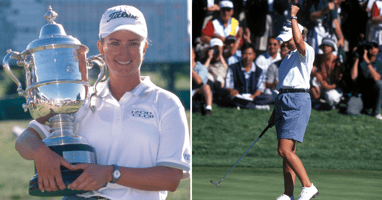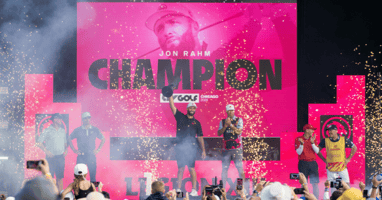Merit Club in Libertyville was the site of Karrie Webb's U.S. Women's Open triumph in 2000...
June 2025 - A Chicago U.S. Open 50 Years Ago
A look back from an esteemed golf writer who covered it
Photographs courtesy of USGA
This article appeared in the June 2025 edition of Chicago District Golfer.
To read more Chicago District Golfer stories, head to our article archive.

Lou Graham hoisted the U.S. Open Championship Trophy at Medinah Country Club following an 18-hole playoff with John Mahaffey. Numerous notable golf legends were in contention throughout the week, including Ben Crenshaw (right).
The 1975 U.S. Open at Medinah Country Club, which occurred 50 years ago this June, was my third as a golf writer for the Chicago Sun-Times and I’ll never forget it. It’s etched in my memory bank for a lot of things besides who won – Lou Graham defeating John Mahaey in an 18-hole Monday playo. I’ve been covering golf for nearly 60 years – including 27 U.S. Opens – but I doubt it would have been nearly that long had the U.S. Open not been brought back to Medinah five decades ago.
Most of the big names of the era were in contention that year: Ben Crenshaw and Hale Irwin (T3), Jack Nicklaus (T7), Tom Watson and Arnold Palmer (T9). Fan interest was high.
But it was Graham and Mahaey who were tied after 72 holes, both having shot 3-over par. Like Rory McIlroy at April’s Masters, Graham went to the final hole of regulation with a one-stroke lead but, like Rory, hit his approach into a greenside bunker and, again like Rory, failed to get up and down, triggering the 18-hole Monday playo, which was the standard way the U.S. Open was decided after a tie in those days. Graham won with an even-par 71 to Mahaey’s 73.
The ’75 championship was Medinah’s second U.S. Open. The first was in 1949 when Cary Middlecoff, a dentist from Memphis, won the title, defeating the great Sam Snead and Clayton Heafner. It was one of four runner-up finishes in the U.S. Open for Snead in the only major championship he didn’t win. Ben Hogan was recovering from a serious auto accident and didn’t play, and it was the last U.S. Open for two-time winner Ralph Guldahl, a legendary player in that period.
Then Chicago waited 26 years for another U.S. Open. Back then, the United States Golf Association (USGA) didn’t schedule U.S. Open sites 10 or 20 years in advance, as it does today. Medinah was announced as the ’75 site in 1972, and that changed a lot of things in the way golf was covered by the Chicago media. Golf didn’t get much attention until the word was out that Medinah had landed the big one. In that long dry spell, Chicago beat writers covered only local events plus the Western Open.
In anticipation of increased reader interest at Medinah, my sports editor suddenly sent me to U.S. Opens at Oakmont in 1973 (where little-known Johnny Miller shot a final-round 63 to win the title) and Winged Foot in 1974 (where Irwin survived on a course so diicult the tournament was dubbed the “Massacre at Winged Foot’’).
 Graham bogeyed the 72nd hole to force the 18-hole playoff between he and Mahaffey.
Graham bogeyed the 72nd hole to force the 18-hole playoff between he and Mahaffey.
Things were a lot different at Medinah. Watson, the young hotshot who had won his first PGA Tour event in the 1974 Western Open at Butler National, started the Medinah Open 67-68, a then-tournament record for 36 holes. He fizzled after that, shooting 78-77 on the weekend.
Frank Beard was the 54-hole leader, but he shot 78 on Sunday and tied for third. The playoff featured Graham, a journeyman, against Mahaey, a young star who would wind up a journeyman. Nevertheless, all week the leaderboard had star power.
Nicklaus, bidding for his fourth U.S. Open win, had a chance to tie for the final round lead with a birdie putt on the 15th hole, but he missed then finished with three bogeys and wound up tied for seventh with Peter Oosterhuis.
Irwin tied for third with Beard along with Crenshaw, then a 23-year-old hotshot who would go on to win two Masters and a Western Open; and Bob Murphy. At 288, they were just one shot out of the playoff.
Palmer tied for ninth – his last top 10 in a U.S. Open – with Watson and Jim Fitzsimons. Future U.S. Open winners Ray Floyd and Andy North tied for 12th.
With Graham failing to get up-and-down on the 72nd hole, he and Mahaey finished regulation play at 3-over-par 287 and headed to the Monday playo. Graham opened a three-stroke lead through 10 holes and went on to capture his only major championship, though he did win six times on the PGA Tour in total.
Interviewing was more casual back then than it is now. Before the playoff, I approached Mahaey while he was having breakfast and asked how he was feeling. He replied, “Not so good. I have an allergy to grass.” I didn’t think he was kidding.
Anyway, Graham’s winner’s check was $40,000. U.S. Open winners didn’t hit the $1 million mark until 2002. Last year’s winner, Bryson DeChambeau, got $4.3 million. Graham was 11 strokes behind Watson at the halfway point, and that led to him making the biggest comeback by a champion.
Though golf’s bigger names didn’t match up to Graham and Mahaey that week, there were no regrets about the drama the tournament provided and Medinah proved a worthy challenge to the world’s best players, though later some would say it played too easy. The Chicago golf crowd was just happy to have a U.S. Open on home soil, and that soil at Medinah would get tested again and again – but on much altered courses.
Medinah members called for renovations of the No. 3 layout for the 1990 U.S. Open (where Irwin would become the oldest U.S. Open champion) and then again for the 1999 and 2006 PGA Championships, where Tiger Woods would prevail. An even bigger redo was just completed in preparation for the 2026 Presidents Cup.
 Jack Nicklaus finished T7 at Medinah, while Arnold Palmer placed T9.
Jack Nicklaus finished T7 at Medinah, while Arnold Palmer placed T9.
Some footnotes from ’75:
After being in contention at Medinah, Mahaey would go on to finish T-10 in the 1975 British Open the following month. He won 10 events on Tour, including the 1978 PGA Championship. Later in life, he worked as an announcer for Golf Channel covering the PGA Tour Champions.
The low amateur was 22-year-old Jerry Pate, who would win the U.S. Open in Atlanta the following year, his first tournament victory as a professional.
Chicago’s own Lance Ten Broeck, then 19 and headed for the University of Texas, was the only other amateur to survive the 36-hole cut. Pate was six strokes behind Graham and Mahaey and six ahead of Ten Broeck.
Gary Groh, who won the Hawaiian Open on the PGA Tour before having a long run as the head professional at Bob ’O Link, matched Pate’s 293 for the 72 holes.
Irwin won the Western Open at Butler National the following year and captured his third U.S. Open at Medinah in 1990 in an epic playo. Irwin and Mike Donald battled through 18 holes before Irwin won on the first extra hole – in effect the first sudden death playoff in U.S. Open history.
Graham, now 87, won his last PGA Tour event in 1979. He made 450 cuts in 623 starts on the PGA Tour and played on three Ryder Cup teams. After turning 50 he played on the PGA Tour Champions through 2001 but never won on the 50-and-over circuit in 239 starts.
Len Ziehm has covered the Chicago golf scene for nearly 60 years, 41 at the Chicago Sun-Times and 16 at the Daily Herald, where he continues to be the golf columnist. He is a member of the Illinois Golf Hall of Fame.






